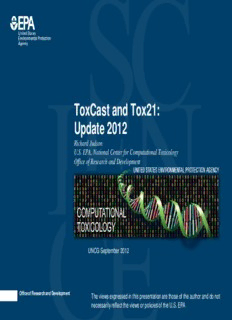Table Of ContentToxCast and Tox21:
Update 2012
Richard Judson
U.S. EPA, National Center for Computational Toxicology
Office of Research and Development
UNCG September 2012
Office of Research and Development
The views expressed in this presentation are those of the author and do not
necessarily reflect the views or policies of the U.S. EPA
The Tox21 Community
2
Tox21 Goals
•
Identify patterns of compound-
induced biological response in
order to:
−
characterize toxicity/disease
pathways
−
facilitate cross-species extrapolation
−
model low-dose extrapolation
•
Prioritize compounds for more
extensive toxicological
evaluation
•
Develop predictive models for
biological response in humans
Problem Statement
Too many chemicals to test with standard
animal-based methods
–Cost, time, animal welfare
Need for better mechanistic data
- Determine human relevance
- What is the Mode of Action (MOA) or Adverse Outcome
Pathway (AOP)?
Office of Research and Development
4
National Center for Computational Toxicology
ToxCast / Tox21 Goals
• Identify molecular targets or biological pathways linked to toxicity
–Chemicals perturbing these can lead to adverse events
• Develop assays for these targets or pathways
–Assays probe “Molecular Initiating Events” or “Key Events” [MIE / KE]
• Develop predictive models: in vitro → in vivo
–“Toxicity Signature”
–Extend to inform biomarkers or bioindicators for key events
• Use signatures:
–Prioritize chemicals for targeted testing (“Too Many Chemicals” problem)
–Suggest / distinguish possible AOP / MOA for chemicals
Office of Research and Development
5
National Center for Computational Toxicology
Signature Generation
In Vitro Data
Predictive Models – “Signatures”
In Vivo Data
Office of Research and Development
6
National Center for Computational Toxicology
ToxCast HTS Assays:
>1100 readouts / effects
Target Family
Assay Provider
Biological Response Response Element
ACEA
cell proliferation and death Transporter Assay Design
Apredica
cell differentiation Cytokines
Attagene viability reporter
mitochondrial depolarization Kinases
BioSeek morphology reporter
protein stabilization Nuclear Receptor
CellzDirect conformation reporter
oxidative phosphorylation CYP450 / ADME
NCGC/Tox21 enzyme reporter
reporter gene activation Cholinesterase
NHEERL MESC membrane potential reporter
gene expression (qNPA) Phosphatases
NHEERL NeuroTox binding reporter
receptor activity Proteases
NHEERL Zebrafish inducible reporter
receptor binding XME metabolism
NovaScreen
GPCRs
Odyssey Thera
Ion Channels
Readout Type
Species Tissue Source
Detection Technology
Single
Human Lung Breast
Multiplexed qNPA and ELISA
Rat Liver Vascular
Multiparametric Fluorescence & Luminescence
Mouse Skin Kidney
Alamar Blue Reduction
Zebrafish Cervix Testis
Cell Format Arrasyscan / Microscopy
Sheep Uterus Brain
Reporter gene activation
Cell free Boar Intestinal Spleen
Spectrophotometry
Cell lines Rabbit Bladder Ovary
Radioactivity
Primary cells Cattle Pancreas Prostate
HPLC and HPEC
Complex cultures Guinea pig Inflammatory Bone
TR-FRET
Free-living embryos
7
ToxCast: HTS Data Timelines
Set Chemicals Assays Endpts Completion Available
ToxCast Phase I 293 ~600 ~1100 2011 Now
ToxCast Phase II 767 ~600 ~1100 Fall 2012 Beginning 12/12
E1K (endocrine) 880 ~50 ~120 Fall 2012 Beginning 12/12
Tox21 8,193 ~25 ~50 Ongoing Beginning 12/12
~600
s
y
a
s
s
A
0 1000 1800 8,200
Chemicals
Office of Research and Development
National Center for Computational Toxicology
8
Tox21 qHTS 10K Library
NCGC EPA NTP
• •
Pesticides actives and NTP-studied compounds
–Drugs
inerts
•
NTP nominations and
–Drug-like
•
Industrial chemicals related compounds
compounds
• •
Endocrine Disruptor NICEATM/ICCVAM
–Active
Screening Program validation reference
pharmaceutical
compounds for regulatory
ingredients •
OECD Molecular
tests
Screening Working
•
Group External collaborators
(e.g., Silent Spring
•
FDA Drug Induced
Institute, U.S. Army Public
Liver Injury Project
Health Command)
•
Failed Drugs
•
Formulated mixtures
Office of Research and Development
National Center for Computational Toxicology
Predictive Model Development from
ToxCast and Other Data
DATABASES
ToxCastDB ToxRefDB
x
in vitro in vivo
ASSAY SELECTION
Univariate Analysis
p-value statistics
ASSAY AGGREGATION
Condense by gene, gene
family, or pathway
ASSAY SET REDUCTION
Reduce by statistics (e.g.
correlation)
MULTIVARIATE MODEL
LDA
Office of Research and Development Model Optimization 11
National Center for Computational Toxicology
Description:Suggest / distinguish possible AOP / MOA for chemicals. 5 (e.g., Silent Spring Generally moving towards more mechanistic/AOP-based models

